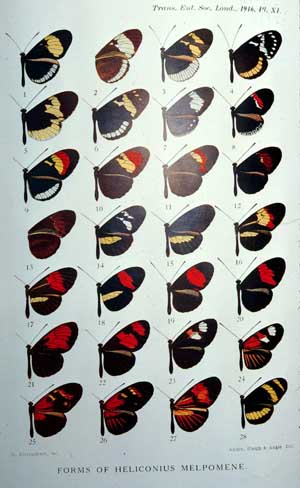|
|
 75 polymorphisms DHJanzen100239.jpg high resolution
|
|
| Throughout this lecture, except for a brief mention with coral snakes, the models and the mimics have been presented as simple species, each with its own (single) color pattern. But again, nature can be more complicated than that. This image of a plate from an old publication offers an example. ALL the butterflies in this plate belong to a single species - the neotropical Heliconia melpomene, a model for both Mullerian and Batesian mimicry systems. Two things. First, at any one place in the neotropics one normally finds just one of these morphs. Second, wherever found, there almost always will be other species of both Mullerian and Batesian mimics in that place with the same color pattern. In short, it appears that in each local area - a valley bottom for example - there has been enough selection to drive the models and mimics into particular color patterns and keep them there. Why are the color patterns not the same from valley to valley? Well, in some species they are. But in other species, like this one, the butterfly is sufficiently genetically plastic that it is evolutionarily pushed to match the other species in the area (as well as the learning abilities of the predators, which must also differ among sites). A great shifting kaleidoscope of results, with various stuttering, stops, and speedups. | ||
back to lecture slides
or skip to: